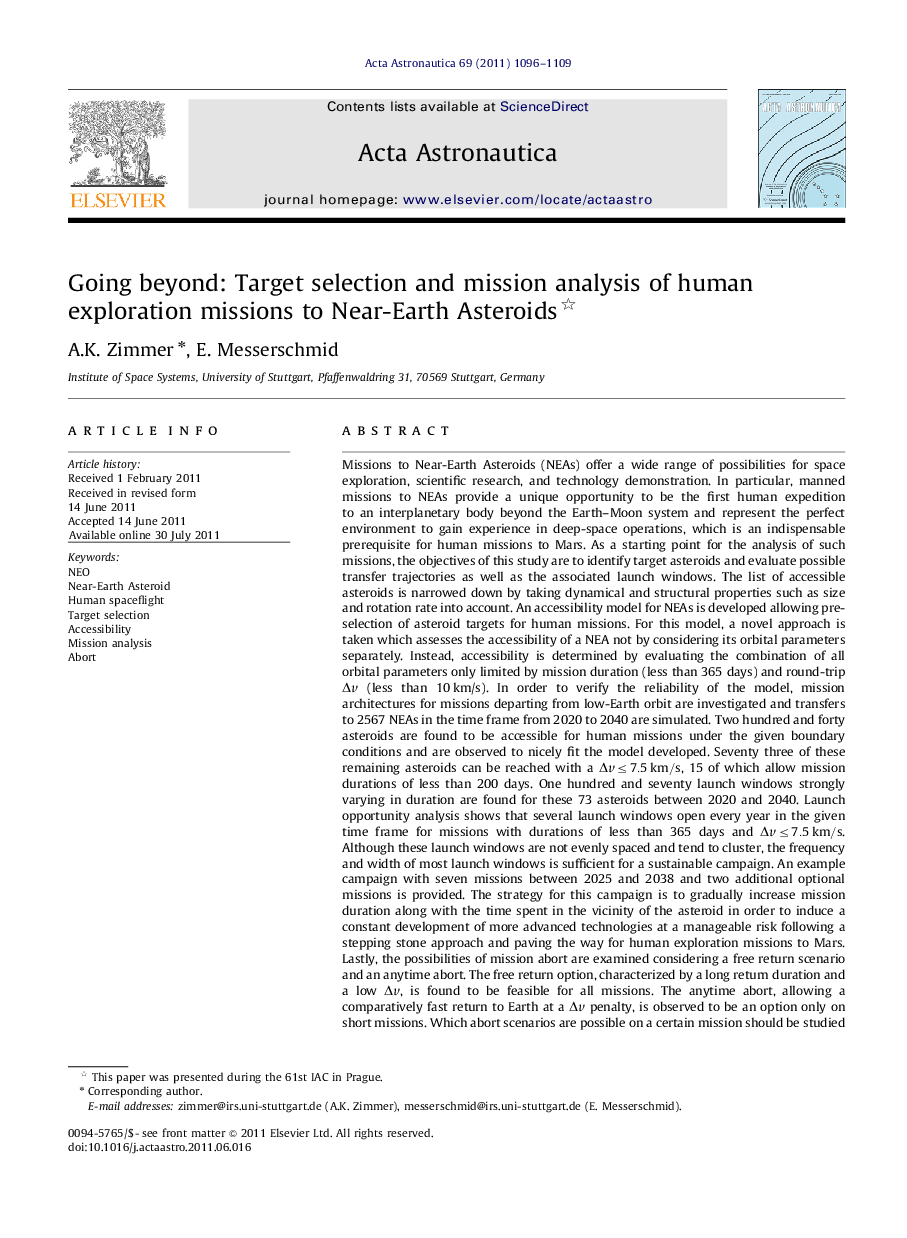| کد مقاله | کد نشریه | سال انتشار | مقاله انگلیسی | نسخه تمام متن |
|---|---|---|---|---|
| 1715518 | 1519979 | 2011 | 14 صفحه PDF | دانلود رایگان |

Missions to Near-Earth Asteroids (NEAs) offer a wide range of possibilities for space exploration, scientific research, and technology demonstration. In particular, manned missions to NEAs provide a unique opportunity to be the first human expedition to an interplanetary body beyond the Earth–Moon system and represent the perfect environment to gain experience in deep-space operations, which is an indispensable prerequisite for human missions to Mars. As a starting point for the analysis of such missions, the objectives of this study are to identify target asteroids and evaluate possible transfer trajectories as well as the associated launch windows. The list of accessible asteroids is narrowed down by taking dynamical and structural properties such as size and rotation rate into account. An accessibility model for NEAs is developed allowing pre-selection of asteroid targets for human missions. For this model, a novel approach is taken which assesses the accessibility of a NEA not by considering its orbital parameters separately. Instead, accessibility is determined by evaluating the combination of all orbital parameters only limited by mission duration (less than 365 days) and round-trip ΔvΔv (less than 10 km/s). In order to verify the reliability of the model, mission architectures for missions departing from low-Earth orbit are investigated and transfers to 2567 NEAs in the time frame from 2020 to 2040 are simulated. Two hundred and forty asteroids are found to be accessible for human missions under the given boundary conditions and are observed to nicely fit the model developed. Seventy three of these remaining asteroids can be reached with a Δv≤7.5km/s, 15 of which allow mission durations of less than 200 days. One hundred and seventy launch windows strongly varying in duration are found for these 73 asteroids between 2020 and 2040. Launch opportunity analysis shows that several launch windows open every year in the given time frame for missions with durations of less than 365 days and Δv≤7.5km/s. Although these launch windows are not evenly spaced and tend to cluster, the frequency and width of most launch windows is sufficient for a sustainable campaign. An example campaign with seven missions between 2025 and 2038 and two additional optional missions is provided. The strategy for this campaign is to gradually increase mission duration along with the time spent in the vicinity of the asteroid in order to induce a constant development of more advanced technologies at a manageable risk following a stepping stone approach and paving the way for human exploration missions to Mars. Lastly, the possibilities of mission abort are examined considering a free return scenario and an anytime abort. The free return option, characterized by a long return duration and a low ΔvΔv, is found to be feasible for all missions. The anytime abort, allowing a comparatively fast return to Earth at a ΔvΔv penalty, is observed to be an option only on short missions. Which abort scenarios are possible on a certain mission should be studied on a case-by-case basis. With these results, the mission analysis of the interplanetary part of human missions to asteroids is concluded, setting mission-specific requirements and boundary conditions required for subsequent spacecraft design.
► Development and confirmation of an accessibility model for the pre-selection of asteroid targets.
► Determination of 240 accessible asteroids and 73 most promising mission targets.
► Determination of launch windows, development of a campaign with seven missions (2025–2038).
► Investigation and confirmation of mission abort options for two contingency scenarios.
Journal: Acta Astronautica - Volume 69, Issues 11–12, December 2011, Pages 1096–1109